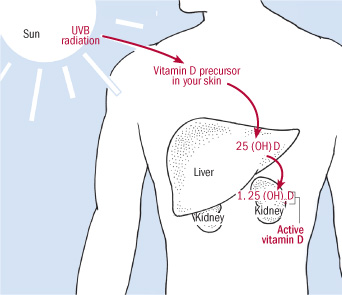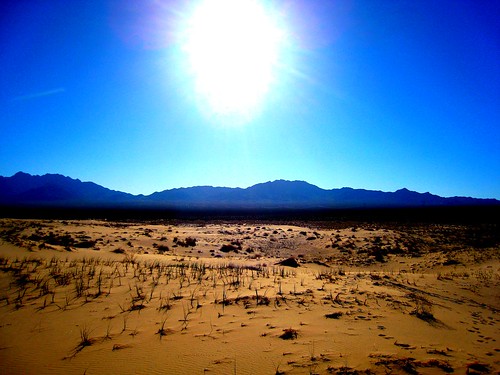Also, a faithful Daily Apple reader wanted to know about sunlight and vitamin D and whether the reduction in both during the winter contributes to the fact that a lot of people tend to get sick more often in the winter.

Sunlight. We all need it.
(Photo from Skirt! Raleigh)
- The sun always rises in the east and sets in the west. This is true no matter where you are on the planet.
- This may make you say, "Duh," but someone told me just the other day that an adult friend of his recently realized this. It was a new and startling revelation to him. So in case anybody else missed that fact, here it is for you.
- The sun emits light and heat, both of which we need to survive and be comfortable here on Earth.
- Nearly all life on earth depends on the sun for fuel. Plants, bacteria, algae, all these things are autotrophs, meaning that they produce their own food. Nearly all of them require sunlight in order to manufacture that food.
- Heterotrophs, which are organisms that rely on others for food, are primarily animals like us. We rely on other animals and plants for our food. So not only do we need sunlight to keep us warm, we need it to grow the food that we need to eat.
- The sun does not "burn" as a fire does, leaving smoke and ash behind. What's really happening is that deep in the very core of the sun, hydrogen atoms get smashed together and when that happens, they become helium.

What the sun really looks like.
(Photo from NASA)
- It's really hard to change anything at its most basic level, yet that is what the sun does all the time. This process, naturally, is enormously powerful, and every time it happens incredible amounts of heat and light are emitted as a byproduct.
- The heat and light are so strong, they flow up from the inner core through the body of the sun which is an enormous, boiling ball of gas, and then out to the photosphere, which is the part of the sun that we can see.

Diagram of the sun and its layers. The core is where the fusion happens; the photosphere is where we see the heat & light being emitted.
(Image from NASA, sourced from Morehead Planetarium at UNC)
- Here's an indicator of how powerful that energy is: the sun is 93 million miles away from us. If we drove 93 miles per hour -- we'd need to get a better car first -- it would take us more than 100 years to get there. Yet it takes the sun's light only 8 minutes to make the trip here.

Kind of hard to look directly at this, isn't it? And this is only a picture.
(Photo from Forecasting Kitsap)
- Sunlight contains all kinds of different types of light. These types are classified by their wavelengths.
- The wavelengths that we can see are grouped into a category called visible light. This is only a portion of the total light coming from the sun.
Diagram of the types of light present in sunlight. The rainbow-colored portion represents the wavelengths that we can see.
(Diagram from DermIS)
- Some of the wavelengths in ultraviolet light are harmful. UVC is very harmful, but our atmosphere absorbs all of that.
- Some of the UVB and UVA wavelengths are also blocked by our atmosphere (clouds, basically). These are less harmful than UVC, though they can damage our skin cells. Ultimately, that's what causes skin cancer.
Same diagram, showing which types of wavelengths are blocked by clouds.
(Diagram from DermIS, modified by the Apple Lady)
- UVB radiation, which has shorter wavelengths, is potentially more damaging than UVA. This is why most sunscreens have UVB radiation protection.
- For a long time dermatologists thought UVA radiation wasn't harmful. But then they realized that though UVA has less energy than UVB, it penetrates deeper into human skin. It is these wavelengths that are responsible for skin aging, and with enough exposure, they too can cause skin cancer.
- So, UVB rays are bad, right, and you should never expose yourself to it? Of course it's not that black and white (har har).
- One of the vitamins that's really important to your health is vitamin D. You need vitamin D to absorb calcium, which makes your bones grow and stay strong. Because of its essential connection with calcium, vitamin D is also very important in preventing osteoporosis.
- Vitamin D has been shown to help prevent heart disease and cardiovascular issues like high blood pressure and diabetes. It's also been shown to be beneficial in preventing various types of cancer including breast, colon, and prostate. People with darker skin need more vitamin D than fair-skinned folks, but they don't often get as much as they need. This is one of the reasons why people with dark skin have a higher incidence of prostate cancer.
- So your body really needs that vitamin D. Got it. What's pretty amazing is that your body makes it all on its own when exposed to sunlight. (That's kind of autotrophic of our bodies, isn't it?)

Here's a very quick overview of the process by which your body uses sunlight to produce vitamin D.
(Diagram from Be Better If You Want)
- But not just any wavelength in sunlight does the trick, it's the UVB wavelengths. The same ones that can give you skin cancer.
- The minimum amount of vitamin D your body needs per day is 200 international units (IUs) if you're under 50. If you're over 50, you need between 400 and 600 IUs. Many nutrition experts say that recommendation is way too low.
- Going out into the summer sun at midday for 10 minutes is enough to give you 10,000 IUs of vitamin D. This will give you more than you need, and since vitamin D is stored in body fat, you don't actually need to be out in the direct sunlight every single day. Health experts say that "sensible sun exposure" should be between 5-30 minutes of direct sun day two or three times a week.

This looks like a good place to get your sunlight / vitamin D requirement.
(Photo from Bitter Cup of Joe)
- The amount of time you spend in the sun depends on your skin color. If you're fair-skinned, 5-10 minutes should do it. If you're darker skinned, 30 minutes may not be long enough.
- It's important that it's direct sunlight. If the sunlight is filtering through glass, it doesn't work. You have to be out under the sun, not in the shade, not in the clouds, and your skin must be exposed and not shielded with sunscreen, for that amount of time.
- Remember, though, all things in moderation. These are UVB rays we're talking about. You need enough to give you that vitamin D, but not so much you'll get skin cancer. Use your noodle and don't bake yourself.

It wouldn't take long at all under this midday sun to give you more than enough vitamin D to last you a while.
(Photo from Rick O! at Flickr)
- If you live north of 42 degrees N latitude (draw a line across the US from Boston to Northern California) or south of 42 degrees S latitude, you're not going to get enough of that direct sunlight from November through February for your body to make the vitamin D that it needs.
- You might also suffer from seasonal affective disorder, and you may be more likely to suffer from insomnia and depression from Nov-Feb, all because of the shorter days and increased cloud cover during this time. And because of the related drop in vitamin D.
- So, are you out of luck in the winter time? Do you just have to suffer in a vitamin D-less world? Nope. You can also get vitamin D from our animal friends.
- Oily fish like tuna and salmon and mackerel are high in vitamin D. Cod liver oil is really the best food source for vitamin D (bleah). You can also get small amounts of vitamin D from beef liver, sardines, egg yolks, and cheese. Surprisingly, some mushrooms also contain varying and small amounts of vitamin D. Food manufacturers have added fairly decent amounts of it to other foods like milk and breakfast cereals and even orange juice.

All good sources of vitamin D.
(Photo from Cheap Ethnic Eatz)
- But vitamin D that comes from foods or supplements isn't utilized as easily by your body. So nutritionists recommend that if you're going to get your vitamin D this way rather than by sunlight, you should get 2,000 IUs of it per day in the winter.
- I didn't see anything from the official health people about the lack of vitamin D contributing to colds and flu. But vitamin D deficiencies have been shown to be a factor in seriously bad autoimmune diseases like multiple sclerosis. So I suppose it's possible that not enough vitamin D could compromise your immune system in other ways and leave you more vulnerable to colds and flu.

Here's some more sunshine for you.
(Photo from civoz on Flickr)
Sources
Challe Hudson, Sunlight, Sun Bright, Morehead Planetarium, University of North Carolina
Absolute Astronomy, Sunlight
NASA Astronomy Picture of the Day, December 12, 1998
National Institutes of Health, Office of Dietary Supplements, "Dietary Supplement Fact Sheet: Vitamin D"
Deborah Kotz, "Time in the Sun: How Much Is Needed for Vitamin D?" US News & World Report, June 23, 2008
MF Holick, Sunlight and vitamin D for bone health and prevention of autoimmune diseases, cancers, and cardiovascular disease (Abstract), American Journal of Clinical Nutrition, December 2004


I live in Phoenix and am addicted to sunlight. We have had a week of rain and it nearly drove me nuts! I have also had skin cancer a number of times, so know that your comment about moderation is very true. www.satisfiedsole.com
ReplyDeleteDid you know the sun is horribly inefficient? Humans are more efficient producers of heat, pound for pound.
ReplyDeleteEs gibt noch zuviel Atommüll im All wenn es Haarp gelingt diese ganze zu beseitigen mit einem nuklear test könnt es die sonnenstrahlen und die hitze auf die Erde durcheinanderbringen.
ReplyDeleteYou might also suffer from seasonal affective disorder, and you may be more likely to suffer from insomnia and depression from Nov-Feb, all because of the shorter days and increased cloud cover during this time. And because of the related drop in vitamin D. lokai wholesale france , lokai wholesale uk
ReplyDelete